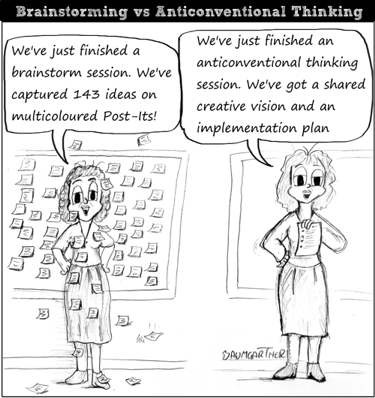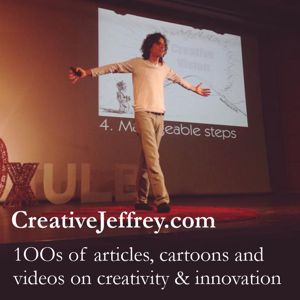
Creative Problem Solving (CPS) Basics
By Jeffrey Baumgartner
Preface
I wrote this article on creative problem solving (CPS) in 2010. However, not long after writing it, a growing unhappiness with the method as a creativity technique caused me to analyse the CPS methodology in detail, identify its flaws and devise a better approach. In 2011, I did that with anticonventional thinking (ACT). I believe that ACT is a far better method for generating highly creative ideas than is CPS. To learn more about the flaws of CPS (and it's simpler variation of brainstorming), read this.
Nevertheless, a large number of creativity consultants and others swear by CPS. So, I leave the original text of the article below.
Creative Problem Solving (CPS) Basics
Creative ideas do not suddenly appear in people's minds for no apparent reason. Rather, they are the result of trying to solve a specific problem or to achieve a particular goal. Albert Einstein's theories of relativity were not sudden inspirations. Rather they were the result of a huge amount of mental problem solving trying to close a discrepancy between the laws of physics and the laws of electromagnetism as they were understood at the time.
Albert Einstein, Leonardo da Vinci, Thomas Edison and other creative geniuses have always worked in the same way. They do not wait for creative ideas to strike them. Rather they focus on trying to solve a clearly stated, at least in their minds, problem.
This approach has been formalised as Creative Problem Solving (CPS). CPS is a simple process that involves breaking down a problem to understand it, generating ideas to solve the problem and evaluating those ideas to find the most effective solutions. Highly creative people tend to follow this process in their heads, without thinking about it. Less naturally creative people simply have to learn to use this very simple process.
Although creative problem solving has been around as long as humans have been thinking creatively and solving problems, it was first formalised as a process by Alex Osborn, who invented traditional brainstorming, and Sidney Parnes. Their Creative Problem Solving Process (CPSP) has been taught at the International Center for Studies in Creativity at Buffalo College in Buffalo, New York since the 1950s.
However, there are numerous different approaches to CPS. Mine is more focused on innovation (that is the implementation of the most promising ideas). It involves seven straightforward steps.
CPS Steps
- Clarify and identify the problem
- Research the problem
- Formulate creative challenges
- Identify insights
- Generate ideas
- Combine and evaluate the ideas
- Draw up an action plan
- Do it! (ie. implement the ideas)
Let us look at each step more carefully.
1. Clarify and identify the problem
Arguably the single most important step of CPS is identifying your real problem or goal. This may seem easy, but very often, what we believe to be the problem is not the real problem or goal. For instance, you may feel you need a new job. However, if you break down your problem and analyse what you are really looking for, it may transpire that the actual issue is that your income does not cover your costs of living. In this case, the solution may be a new job, but it might also be to re-arrange your expenses or to seek a pay rise from your existing employer.
Five Whys
The best way to clarify the problem and understand the underlying issues is to ask yourself -- or better still, ask a friend or family member to ask you -- a series of questions about your problem in order to clarify the true issues behind the problem. The first question to ask is simply: "why is this a problem?" or "why do I wish to achieve this goal?". Once you have answered that, ask yourself "why else?" four more times.
For instance, you might feel you want to overcome your shyness. So, you ask yourself why and you answer: "because I am lonely". Then ask yourself "why else?" four times. You answer: "because I do not know many people in this new city where I live", "because I find it hard to meet people", "because I am doing many activities alone" and "because I would like to do activities with other people who share my interests". This last "why else" is clearly more of the issue than reducing shyness. Indeed, if you had focused your creative energy on solving your shyness issue, you would not have actually solved the real problem. On the other hand, if you focused your creative energy on finding people with whom to share activities, you would be happier without ever having to address the shyness issue.
And More Questions
In addition, you can further clarify your problem by asking questions like: "what do I really wish to accomplish?", "what is preventing me from solving this problem/achieving the goal?", "how do I envision myself in six months/one year/five years [choose most relevant time span] as a result of solving this problem?" and "are my friends dealing with similar problems? If so, how are they coping?"
By the time you have answered all these questions, you should have a very clear idea of what your problem or real goal is.
Criteria
The final step is to decide what criteria you will eventually use to evaluate or judge the ideas. Are there budget limitations, timeframe or other restrictions that will affect whether or not you can go ahead with an idea? What will you want to have accomplished with the ideas? What do you wish to avoid when you implement these ideas? Think about it and make a list of three to five evaluation criteria. Then put the list aside. You will not need it for a while.
2. Research the Problem
The next step in CPS is to research the problem in order to get a better understanding of it. Depending on the nature of the problem, you may need to do a great deal of research or very little. The best place to start these days is with your favourite search engine. But do not neglect good old fashioned sources of information and opinion. Libraries are fantastic for in-depth information that is easier to read than computer screens. Friends, colleagues and family can also provide thoughts on many issues. Fora on sites like LinkedIn and elsewhere are ideal for asking questions. There's nothing an expert enjoys more than imparting her knowledge. Take advantage of that. But always try to get feedback from several people to ensure you get rounded information.
3. Formulate Creative Challenges
By now, you should be clear on the real issues behind your problems or goals. The next step is to turn these issues into creative challenges. A creative challenge is basically a simple question framed to encourage suggestions or ideas. In English, a challenge typically starts with "In what ways might I [or we]...?" or "How might I...?" or "How could I...?"
Creative challenges should be simple, concise and focus on a single issue. For example: "How might I improve my Chinese language skills and find a job in Shanghai?" is two completely separate challenges. Trying to generate ideas that solve both challenges will be difficult and, as a result, will stifle idea generation. So separate these into two challenges: "How might I improve my Chinese language skills" and "How might I find a job in Shanghai". Then attack each challenge individually. Once you have ideas for both, you may find a logical approach to solving both problems in a coordinated way. Or you might find that there is not co-ordinate way and each problem must be tackled separately.
Creative challenges should not include evaluation criteria. For example: "How might I find a more challenging job that is better paying and situated close to my home?" If you put criteria in the challenge, you will limit your creative thinking. So simply ask: "How might a I find a more challenging job?" and after generating ideas, you can use the criteria to identify the ideas with the greatest potential. (Here's a more detailed article on formulating creative challenges)
4. Identify Insights and Inspiration
You are almost ready to start generating ideas, but before you work on ideas in response to your challenge, think about what might provide insight and inspiration that will help you generate ideas. Some forms of inspiration are unrelated to the challenge. For instance, I like to go for long walks for inspiration. I also find the music of Bach provides me with deeper vision into problems. Other people like to lay down or take a bath. Whatever works for you is great.
You may seek inspiration before you generate ideas, for instance by reading up on research related to the problem. Or you might seek inspiration during the idea generation session by brainstorming in a beautiful location. If the challenge is a B2B (business to business) issue, why not brainstorm in one of your customers' premises?
5. Generate Ideas
Finally, we come to the part most people associate with brainstorming and creative problem solving: idea generation. And you probably know how this works. Take only one creative challenge. Give yourself some quiet time and try to generate at least 50 ideas that may or may not solve the challenge. You can do this alone or you can invite some friends or family members to help you.
Irrespective of your idea generation approach, write your ideas on a document. You can simply write them down in linear fashion, write them down on a mind-map, enter them onto a computer document (such as MS Word or OpenOffice) or use a specialised software for idea generation. The method you use is not so important. What is important is that you follow these rules:
-
Write down every idea that comes to mind. Even if the idea is ludicrous, stupid or fails to solve the challenge, write it down. Most people are their own worst critics and by squelching their own ideas, make themselves less creative. So write everything down. NO EXCEPTIONS!
-
If other people are also involved, insure that no one criticises anyone else's ideas in any way. This is called squelching, because even the tiniest amount of criticism can discourage everyone in the group for sharing their more creative ideas. Even a sigh or the rolling of eyes can be critical. Squelching must be avoided!
-
If you are working alone, don't stop until you've reached your target of 50 (or more) ideas. If you are working with other people, set a time limit like 15 or 20 minutes. Once you have reached this time limit, compare ideas and make a grand list that includes them all. Then ask everyone if the have some new ideas. Most likely people will be inspired by others' ideas and add more to the list.
If you find you are not generating sufficient ideas, give yourself some inspiration. A classic trick is to open a book or dictionary and pick out a random word. Then generate ideas that somehow incorporate this word. You might also ask yourself what other people whom you know; such as your grandmother, your partner, a friend or a character on you favourite TV show, might suggest.
Brainstorming does not need to occur at your desk. Take a trip somewhere for new inspiration. Find a nice place in a beautiful park. Sit down in a coffee shop on a crowded street corner. You can even walk and generate ideas.
In addition, if you browse the web for brainstorming and idea generation, you will find lots of creative ideas on how to generate creative ideas!
One last note. If you are not in a hurry, wait until the next day and then try to generate another 25 ideas, ideally do this in the morning. Research has shown that our minds work on creative challenges while we sleep. Your initial idea generation session has been good exercise and has certainly generated some great ideas. But it will probably also inspire your unconscious mind to generate some ideas while you sleep. Don't lose them!
6. Combine and Evaluate Ideas
After you have written down all of your ideas, take a break. It might just be an hour. It might be a day or more. Then go through the ideas. Related ideas can be combined together to form big ideas (or idea clusters).
Then, using the criteria you devised earlier, choose all of the ideas that broadly meet those criteria. This is important. If you focus only on the "best" ideas or your favourite ideas, the chances are you will choose the less creative ones! Nevertheless, feel free to include your favourite ideas in the initial list of ideas.
Now get out that list of criteria you mad earlier and go through each idea more carefully. Consider how well it meets each criterion and give it a rating of 0-5 points with five indicating a perfect match. If an idea falls short of a criterion, think about why this is so. Is there a way that it can be improved in order to increase its score? If so, make a note. Once you are finished, all of the ideas will have an evaluation score. Those ideas with the highest score best meet your criteria. They may not be your best ideas or your favourite ideas, but they are most likely to best solve your problem or enable you t achieve your goal.
Depending on the nature of the challenge and the winning ideas, you may be ready to jump right in and implement your ideas. In other cases, ideas may need to be developed further. With complex ideas, a simple evaluation may not be enough. You may need to do a SWOT (strengths, weaknesses, opportunities and threats) or discuss the idea with others who will be affected by it. If the idea is business related, you may need to do a business case, market research, build a prototype or a combination of all of these.
Also, bear in mind that you do not need to limit yourself to one winning idea. Often you can implement several ideas in order to solve your challenge.
* There are a number of variations on the approach to CPS. All follow roughly the same steps. This is the approach I used to use.
© 2010, 2014 creativejeffrey.com
Recent Articles
Leading Diverse Teams
Filed under: Business Innovation
Diverse teams are more innovative and smarter than homogeneous ones. But, they are also harder to manager. Here are some tips. By Jeffrey Baumgartner -- Read the article...
Questions you should ask when an innovative project fails
Filed under: Business Innovation
You can learn a lot from the failure of an innovative project, but you need to ask the right questions. Here are those questions. By Jeffrey Baumgartner -- Read the article...
Unmarketing the Competition
Filed under: Business Innovation
A look at creative, but unethical dirty trick marketing campaigns designed to damage the competition By Jeffrey Baumgartner -- Read the article...
Imaginativefulness and the Fisherman
Filed under: Creativity
What does a fisherman wearing a cycling helmet have to do with imaginativefulness? Quite a lot, it seems. By Jeffrey Baumgartner -- Read the article...
Actually, Criticising Ideas Is Good for Creativity
Filed under: Creativity
People have long assumed criticising ideas in a brainstorm inhibits creativity. Research and experience shows that is wrong By Jeffrey Baumgartner -- Read the article...
Imaginativefulness
Filed under: Creativity
Imaginativefulness is a state of heightened imagination in which your mind allows thoughts, memories and ideas to play with each other freely. By Jeffrey Baumgartner -- Read the article...
Why and How to Exploit Alternative Uses for Your Products
Filed under: Business Innovation
Discovering new ways customers use, misuse and could use your products can inspire innovation. Jeffrey Baumgartner explains. By Jeffrey Baumgartner -- Read the article...
The Cost of Not Innovating
Filed under: Business Innovation
If your company fails to innovate, you pay a steep price in terms of loss of leadershop, tight margins, missed opportunities and more. By Jeffrey Baumgartner -- Read the article...
Don't Trust the Status Quo
Filed under: Creativity
Jeffrey Baumgartner has never trusted the status quo. He explains why this is so and why you should also not trust the status quo By Jeffrey Baumgartner -- Read the article...
Index of all creative articles...




